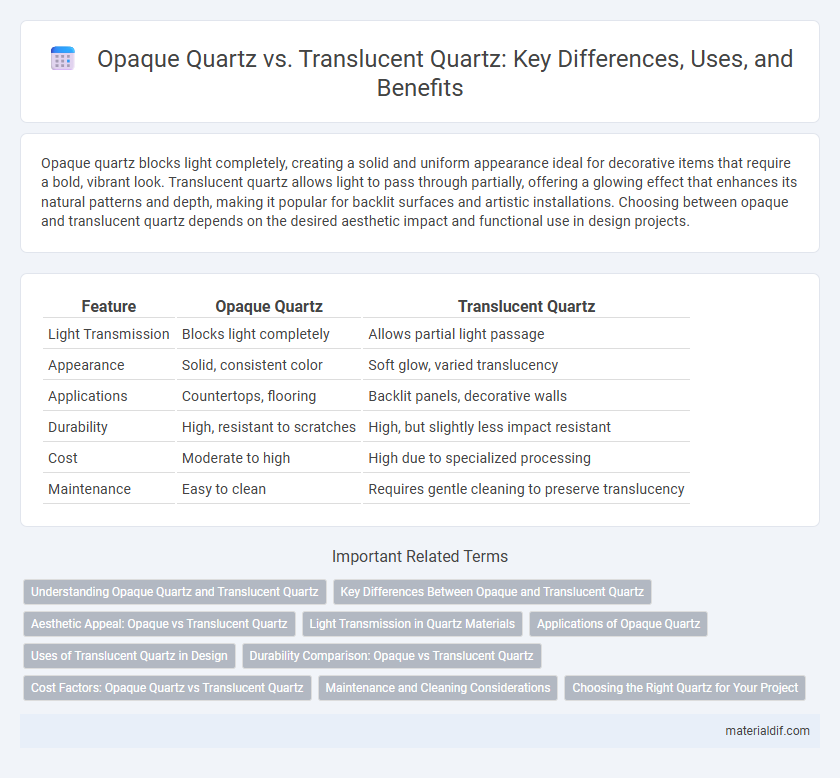Opaque quartz blocks light completely, creating a solid and uniform appearance ideal for decorative items that require a bold, vibrant look. Translucent quartz allows light to pass through partially, offering a glowing effect that enhances its natural patterns and depth, making it popular for backlit surfaces and artistic installations. Choosing between opaque and translucent quartz depends on the desired aesthetic impact and functional use in design projects.
Table of Comparison
| Feature | Opaque Quartz | Translucent Quartz |
|---|---|---|
| Light Transmission | Blocks light completely | Allows partial light passage |
| Appearance | Solid, consistent color | Soft glow, varied translucency |
| Applications | Countertops, flooring | Backlit panels, decorative walls |
| Durability | High, resistant to scratches | High, but slightly less impact resistant |
| Cost | Moderate to high | High due to specialized processing |
| Maintenance | Easy to clean | Requires gentle cleaning to preserve translucency |
Understanding Opaque Quartz and Translucent Quartz
Opaque quartz exhibits a lack of light transmission, making it ideal for decorative applications where solid color and texture are desired without any translucency. Translucent quartz allows light to pass through partially, enhancing its appeal in design elements requiring a luminous or glowing effect. Understanding the differences between opaque and translucent quartz is essential for selecting the right material for countertops, tiles, or artistic installations where visual impact and light interaction matter.
Key Differences Between Opaque and Translucent Quartz
Opaque quartz lacks light transmission due to its higher density and presence of impurities, creating a solid, non-transparent appearance ideal for applications requiring durability and a uniform look. Translucent quartz allows partial light to pass through, featuring a semi-transparent quality that enhances aesthetic appeal in decorative surfaces and lighting designs. The key differences lie in light interaction, with opaque quartz offering robust structural integrity and translucency providing visual depth and subtle glow effects.
Aesthetic Appeal: Opaque vs Translucent Quartz
Opaque quartz offers a rich, consistent color that enhances modern and minimalist interior designs by providing a sleek, uniform surface with no visible light transmission. Translucent quartz allows light to pass through, creating a dynamic, glowing effect ideal for backlit countertops and decorative installations that emphasize depth and warmth. The choice between opaque and translucent quartz significantly impacts the aesthetic appeal, influencing mood, ambient lighting, and the perception of space within a room.
Light Transmission in Quartz Materials
Opaque quartz blocks light transmission completely, making it ideal for applications requiring no light penetration, such as countertops and decorative surfaces where privacy or a solid appearance is desired. Translucent quartz allows partial light transmission, scattering light without clear visibility, enhancing aesthetic appeal in backlit panels or architectural features that benefit from soft, diffused illumination. The difference in light transmission properties between opaque and translucent quartz significantly influences their suitability for lighting design and functional applications in both interior and exterior environments.
Applications of Opaque Quartz
Opaque quartz offers exceptional durability and resistance to chemical corrosion, making it ideal for industrial applications such as refractory linings, crucibles, and semiconductor manufacturing components. Its low thermal expansion and high melting point enable it to withstand extreme temperatures, ensuring stability in high-heat environments. Opaque quartz is also extensively used in optical devices and electronic substrates where light diffusion and insulation are critical.
Uses of Translucent Quartz in Design
Translucent quartz is highly valued in design for its ability to diffuse light softly, creating ambient and visually appealing interiors. Its use in countertops, backsplashes, and decorative panels enhances spaces with a luminous, ethereal quality while maintaining durability. Unlike opaque quartz, translucent quartz allows for creative lighting effects, making it ideal for modern architectural applications and bespoke furniture designs.
Durability Comparison: Opaque vs Translucent Quartz
Opaque quartz exhibits higher durability due to its dense, tightly packed crystal structure, making it more resistant to scratches, impacts, and wear compared to translucent quartz. Translucent quartz, while visually appealing with its light-diffusing properties, tends to be slightly less robust and more susceptible to surface damage under heavy use. This makes opaque quartz a preferred choice for high-traffic surfaces and applications demanding maximum longevity.
Cost Factors: Opaque Quartz vs Translucent Quartz
Opaque quartz generally costs less than translucent quartz due to simpler manufacturing processes and lower material purity requirements. Translucent quartz demands higher-grade raw materials and refined fabrication techniques, increasing production expenses. These cost factors influence pricing differences in applications such as countertops and decorative surfaces.
Maintenance and Cleaning Considerations
Opaque quartz requires less frequent cleaning since its surface better hides fingerprints and stains, making maintenance simpler in high-traffic areas. Translucent quartz demands more careful cleaning to preserve its light-transmitting properties and prevent cloudiness or surface damage from abrasive cleaners. Using pH-neutral, non-abrasive cleaning agents is essential for both types to maintain their aesthetic and structural integrity over time.
Choosing the Right Quartz for Your Project
Opaque quartz offers robust durability and a consistent, solid appearance ideal for high-traffic countertops and surfaces requiring stain resistance. Translucent quartz allows light to pass through, creating a luminous aesthetic perfect for decorative applications like backsplashes and accent walls. Selecting the right quartz depends on balancing functional needs such as durability and maintenance with desired visual effects in your project design.
Opaque Quartz vs Translucent Quartz Infographic

 materialdif.com
materialdif.com